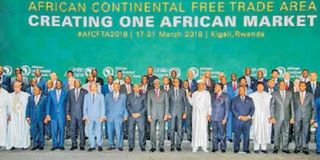Risks to manage in the African Free Trade Area

Delegates during the African Continental Free Trade Area business forum in Kigali, Rwanda, in March. PHOTO | FILE
What you need to know:
While some countries may have issues with the AfCTA, most governments are behind it and momentum will continue to build to make it a reality.
The Africa Continental Free Trade Area (AfCTA) seeks to integrate African economies and pull together a market with a consumer spending power of $1.4 trillion by 2020, and increase intra-African trade by $35 billion by 2022. While some countries may have issues with the AfCTA, most governments are behind it and momentum will continue to build to make it a reality.
AfCTA is viewed as a game- changer that will allow the free movement of goods and services across the continent, allowing African businesses to tap deeper into the sizeable and growing markets. However, there are a few risks that ought to be managed going forward.
Financing of infrastructure
The first has to do with the financing of infrastructure that will interconnect the continent. Africa has an annual infrastructure financing deficit of about $93 billion. An obvious next step will be the business of raising funds to build the infrastructure Africa needs because without it, AfCTA will remain a good idea with no lived benefits on the ground.
Rising debt levels
Given concerns with rising debt levels of African countries, coupled with queries on the management of public funds, there is a risk that AfCTA can facilitate a debt binge to finance infrastructure in a context of poor institutional controls and capacity to ensure projects are efficiently financed and developed.
African governments have to manage this by ensuring infrastructure plans are financed responsibly, that money reaches the projects and that they are completed in a timely manner.
Without these controls, the sheer scale of financing that can be attracted in the context of AfCTA may trigger debt distress in many countries.
Policy change
The second risk is that given Africa’s underdeveloped manufacturing and propensity to export raw commodities; without coordinated policy change, AfCTA may entrench and enable this dynamic. A cynic will point out that given where Africa is now, AfCTA may do more harm than good. By opening up Africa’s borders and markets, AfCTA will make it easier than ever to extract even larger amounts of raw materials from even more of the continent.
AfCTA can also open African markets even further to others and unintentionally facilitate the dumping of manufactured goods by other countries. Is Africa able to process all its oil, gold, coltan, titanium, copper, agricultural produce etc?
If not, to whom is AfCTA really opening up Africa? And who will actually capture market share in Africa via AfCTA?
Coordinated action
This leads to the final point, which is that the implementation of AfCTA must be correlated with focused and coordinated action across Africa to industrialise.
Let African industries and manufacturers get the attention required to catalyse their development. The African Development Bank has just released a report on strategies, policies, institutions and financing required to industrialise Africa.
Let governments draw from such documents as they develop and implement their industrialisation policies and strategies. In doing so, Africa will be in a much stronger position to leverage AfCTA and ensure native companies capture market share in a manner that propels wealth creation and development in the continent.




